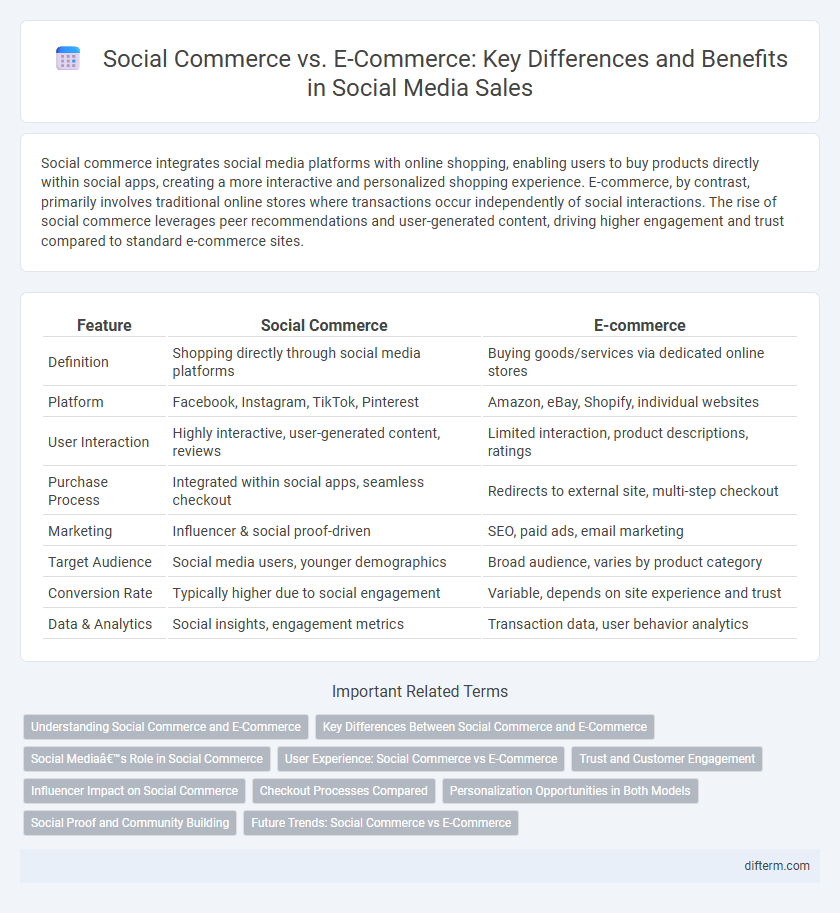Social commerce integrates social media platforms with online shopping, enabling users to buy products directly within social apps, creating a more interactive and personalized shopping experience. E-commerce, by contrast, primarily involves traditional online stores where transactions occur independently of social interactions. The rise of social commerce leverages peer recommendations and user-generated content, driving higher engagement and trust compared to standard e-commerce sites.
Table of Comparison
| Feature | Social Commerce | E-commerce |
|---|---|---|
| Definition | Shopping directly through social media platforms | Buying goods/services via dedicated online stores |
| Platform | Facebook, Instagram, TikTok, Pinterest | Amazon, eBay, Shopify, individual websites |
| User Interaction | Highly interactive, user-generated content, reviews | Limited interaction, product descriptions, ratings |
| Purchase Process | Integrated within social apps, seamless checkout | Redirects to external site, multi-step checkout |
| Marketing | Influencer & social proof-driven | SEO, paid ads, email marketing |
| Target Audience | Social media users, younger demographics | Broad audience, varies by product category |
| Conversion Rate | Typically higher due to social engagement | Variable, depends on site experience and trust |
| Data & Analytics | Social insights, engagement metrics | Transaction data, user behavior analytics |
Understanding Social Commerce and E-Commerce
Social commerce integrates direct purchasing within social media platforms, leveraging user-generated content and social interactions to influence buying decisions. E-commerce involves online retail through standalone websites or apps, focusing on a broad product catalog and conventional digital marketing strategies. Understanding the distinct consumer behaviors and engagement patterns in social commerce compared to traditional e-commerce is crucial for optimizing sales and customer experience.
Key Differences Between Social Commerce and E-Commerce
Social commerce integrates shopping experiences within social media platforms, enabling users to buy products directly through apps like Instagram and Facebook without leaving the interface. E-commerce involves traditional online retail websites like Amazon or Shopify, where users browse and purchase items through dedicated e-commerce platforms. Key differences include social engagement features, real-time interactions, and influencer-driven marketing in social commerce, while e-commerce focuses on extensive product catalogs, search functionality, and secure checkout processes.
Social Media’s Role in Social Commerce
Social media platforms drive social commerce by integrating shopping features directly into user experiences, enabling seamless product discovery and purchase within apps like Instagram, Facebook, and TikTok. This integration leverages user-generated content, influencer marketing, and social proof to boost consumer trust and engagement, significantly enhancing conversion rates compared to traditional e-commerce sites. The interactive nature of social media fosters community-driven shopping behaviors, making social commerce a dynamic and personalized retail channel.
User Experience: Social Commerce vs E-Commerce
Social commerce enhances user experience by integrating shopping directly within social media platforms, enabling seamless interactions, real-time reviews, and tailored recommendations based on user behavior and social networks. E-commerce platforms typically offer extensive product selections and advanced search functionalities, but often require users to navigate away from their social environments to complete purchases, which can disrupt engagement. The immersive and interactive nature of social commerce fosters higher engagement rates and quicker purchase decisions through personalized content and social proof.
Trust and Customer Engagement
Social commerce leverages interactive features on social media platforms to build trust through authentic user reviews and peer recommendations, enhancing customer engagement more effectively than traditional e-commerce. Real-time communication and personalized content foster strong relationships between brands and consumers, driving higher conversion rates. Trust signals such as influencer endorsements and community interactions create a seamless shopping experience that encourages repeat purchases and brand loyalty.
Influencer Impact on Social Commerce
Influencer impact on social commerce significantly enhances consumer trust and drives purchase decisions through authentic product endorsements on platforms like Instagram and TikTok. Studies indicate that 49% of shoppers rely on influencer recommendations when buying online, emphasizing the role of social proof in social commerce success. Unlike traditional e-commerce, social commerce leverages influencers' engaged audiences to create interactive and personalized shopping experiences.
Checkout Processes Compared
Social commerce checkout processes are designed for seamless in-app transactions, reducing friction by enabling users to purchase products without leaving social media platforms like Instagram or Facebook. In contrast, traditional e-commerce often requires redirection to external websites, introducing multiple steps that can increase cart abandonment rates. The streamlined, integrated checkout experiences in social commerce leverage features such as saved payment details and one-click purchasing to enhance conversion rates and customer satisfaction.
Personalization Opportunities in Both Models
Social commerce leverages real-time user data and social interactions to deliver hyper-personalized shopping experiences, integrating product recommendations based on social behaviors and influencer endorsements. E-commerce platforms utilize extensive algorithms and customer data analytics to tailor user interfaces, offer customized promotions, and optimize product discovery through personalized search results. Both models enhance personalization, but social commerce uniquely benefits from the immediacy of peer influence and community-driven content to increase engagement and conversion rates.
Social Proof and Community Building
Social commerce leverages authentic user-generated content and reviews to enhance Social Proof, significantly boosting consumer trust and purchase intent compared to traditional e-commerce. Community Building fosters interactive brand experiences through social media platforms, creating loyal customer networks that drive repeat sales and organic growth. Integrating these social dynamics results in higher conversion rates and deeper customer engagement than standard online retail models.
Future Trends: Social Commerce vs E-Commerce
Social commerce is poised to surpass traditional e-commerce in growth by leveraging integrated social media platforms for seamless shopping experiences. Emerging technologies like augmented reality and AI-driven personalized recommendations will further enhance social commerce engagement and conversion rates. E-commerce will continue evolving with advanced logistics and AI-based analytics but may lag behind in real-time consumer interaction and social integration.
social commerce vs e-commerce Infographic

 difterm.com
difterm.com